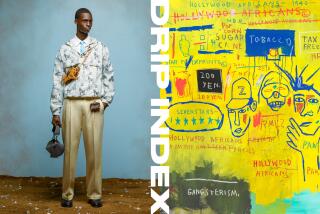Hermes Settles Easily Into the World of Luxury
TOKYO â Jean-Louis Dumas-Hermes looked away from the duck-liver pate, whipped out his Mont-Blanc pen and started drawing diagrams again.
âBusiness doubled in three years, but weâre still halfway from Rolex and Rolex only makes watches. We made one billion francs this year (roughly $150 million), but itâs still one month of IBM--so what!â
In the patrician world of French luxury goods, Dumas-Hermes, head of the house of Hermes, is an impatient and unconventional leader.
He can accomplish just as much hosting a party in an ancient Japanese teahouse or sipping Singapore Slings at the Long Bar in Raffles Hotel, as he can sitting in his office above the Faubourg Saint Honore in Paris, quietly churning out the expensive hand-stitched leather products for which his company is famous.
It is the year of Hermesâ 150th anniversary, and already Dumas-Hermes has masterminded an outrageously ambitious fireworks show from a launching pad on the Seine in Paris. And now, it is the âEarth tour,â for which he whisked half a dozen flabbergasted business journalists from Paris for two days of non-stop parties in Los Angeles and more of the same in Tokyo and Singapore for the sole purpose of âshowing our vitality. If we look to you old,â he says, âweâre finished.â
Perhaps his most shocking gesture, however, was the unveiling here of a futuristic line of luggage, made of glass-like, epoxy-glazed carbon fiber, the same material used on Formula I race-car bodies and the nose of the European space shuttle Hermes (no relation).
As 150 Japanese reporters looked on in stunned silence, the first two such items, a standard attache case and a slightly larger overnight case, were launched recently with a âStar Warsâ-like light show, pulsating music and artificial fog.
For Dumas-Hermes, it was the moment when Hermes finally went high-tech.
Tantalized with the future but devoted to the past, the 49-year-old executive sees the Espace collection as one of the vehicles that will transport his company into the 21st Century, and not because the products (which, in true Hermes style, are lined in lush, caramel-color leather) are any less expensive than their all-leather counterparts, selling at about $3,000 apiece.
Dumas-Hermes foresees the day when leather may eventually out-price itself--even at Hermes, where $2,000 handbags are the norm.
âNone of us is tempted to reduce the quality because of a possible price resistance, and Iâll fight to the very last minute to see that leather should exist,â he says in his usual rapid-fire delivery. But he adds that it would be âfoolishâ not to consider the day when leather is too precious to use.
âOne adviser told me: âMake your new factory for leather goods for the time when leather may not exist.â I donât say always everything should be handmade. The point is the time you take to be sure every step in building a product is controlled. My message is: The past is helping the future.â
When he is not ruminating about designs for printed-silk scarfs or new handbags, the relentlessly energetic Dumas-Hermes is airborne--collecting socks, toothbrushes and whatever other perks of first-class travel there are to collect--en route to one of the companyâs 200 worldwide retail outlets. This often means he is somewhere in the Orient, Hermesâ fastest growing region.
In Japan alone, there are 41 Hermes shops with two more on the way. All totaled, between 20% and 25% of the companyâs sales are made to Japanese customers.
In the nine years since his cousins voted him into the head office, the aggressive and growth-oriented Dumas-Hermes has shaken up the staid family business, launching a stylish advertising campaign, learning to court the press and hiring young, knowledgeable managers from outside the family to head each of the companyâs divisions.
Describing his approach as âmultilocal,â he doesnât believe so much in shipping products off to distant locales as he does in building up strong business structures in different geographical markets where he makes a point of learning about the ways of the people.
In Los Angeles, for example, where his whirlwind promotional tour kicked off with a dinner at the home of entertainer Sammy Davis Jr., Dumas-Hermes was less concerned with meeting the local Whoâs Who, such as actress Lucille Ball and oil magnate Marvin Davis, than with the environment.
âThereâs an extraordinary vegetation smell,â he noted at one point in the evening, âand a certain degree of humidity.
âThis party to me is so California, the mixture, the way people dress. There is a majesty in this tent,â he said glancing upward. âI like it. In Paris it would be formal, everyone would put a mask on.
âOne of my key points is: Letâs be different. I am just the opposite of some luxury names who try to make a puppet out of you saying: âFollow me and youâll be the perfect aristocratic WASP,â âFollow me and youâll be the perfect Italian count.â Hermes is a tool for better living, for making you be more yourself. Hermes is at the service of the customers.â
Not immune to grand statements, Dumas-Hermes is, after all, a member of an exclusive club of venerable French companies with long and impressive histories.
It began in 1837 when Thierry Hermes opened his own workroom making harnesses for the carriage trade. When his son, Emile Charles, joined him in 1870, they added saddles to their inventory.Eventually, jewelry, perfumes and printed silk scarfs and ties followed.
Dumas-Hermes, great-great-grandson of Thierry, has introduced even more products. Aside from the futuristic carbon-fiber luggage, there is a new faience collection, incorporating the classical Provencal techniques of pottery making. And recently, he reintroduced Eau DâHermes, a unisex scent created in the â50s by famed perfumer Edmond Roudnitska.






